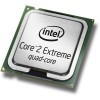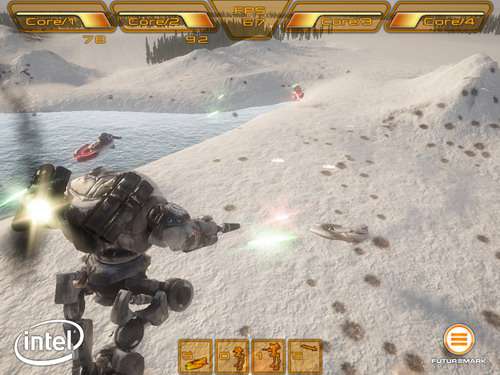- Qualcomm Launches Snapdragon 4 Gen 2 Mobile Platform
- AMD Launches Ryzen PRO 7000 Series Mobile & Desktop Platform
- Intel Launches Sleek Single-Slot Arc Pro A60 Workstation Graphics Card
- NVIDIA Announces Latest Ada Lovelace Additions: GeForce RTX 4060 Ti & RTX 4060
- Maxon Redshift With AMD Radeon GPU Rendering Support Now Available
Intel Core 2 Extreme QX6850 Quad-Core

Intel today is announcing their 1333FSB Core 2 line-up, which consists of three dual-cores, including the E6750 we previewed a few weeks ago, and also the 3.0GHz quad-core that we are testing out today. Read on as we explore all of what Intel’s latest flagship processor has to offer.
Page 9 – Gaming on Quad
Dual Core CPUs have been in consumers hands for a couple years now, but it was a slow process before we started seeing applications exploit them. Today, things are a lot different. Most of our everyday applications are multi-threaded including a few that we benchmarked earlier. Nero is one of the ones that stands out in my mind, because I used it regularly. It’s not always the multi-threaded applications that people care about though, it’s the fact that they have spare cores to play with.
There has been one big gripe ever since we first received Dual Core CPUs, that being that there are no games out there that support them. The benefits would be obvious. Some newer games are not just taxing on your graphics card, but CPU as well. Using a Dual Core, you’d essentially be doubling the amount of information that can be passed along. It sounds good in thought, but the problem is that not many developers are taking an initiative.
The most common complaint from game studios is that making a multi-thread game is not easy. In fact, it requires additional training and understanding in order to execute properly. This results in a more costly title in the end. Time is another factor, for obvious reasons. Planning out a multi-core capable game takes a lot of planning to make sure it flows as it should.
That being said, the future for gaming is still bright. It will still be a while before it becomes commonplace, but later this year we should be seeing a few titles that will greatly benefit from additional cores. Will these extra cores wipe out the need for a physics card? Probably not right off the get go, if at all. But in the end, we will likely see extra cores used as common practice far before we see a PhysX card becoming mainstream, simply because -every- gamer out there will have a CPU, while add-on cards are another expense.
While visiting Intel at this past January’s CES, they showed off two demos, both of which I used more in-depth over the past week. The first was their Ice Storm Fighters, which was developed by Futuremark exclusively for them. There is one reason this demo was developed and one reason only, to show the immediate benefits that a multi-core processor can have on gaming. Reminiscent to the Tie Fighter scene in Star Wars episode IV, Ice Fighters consists of a large snow covered level that has many vehicles and Mechs right in the heat of battle.
There are two options at the main screen, Low and High. High is for Quad-Core CPUs while Low is for Dual-Core. This demo stresses ALL cores like no other game, so if you choose High while using a Dual-Core, it will be laggier than downloading a webpage off a 2800 Baud modem. You have the ability to add or remove bots if you want, but the more you add will simply slow down the demo even further. Even with just 20 units on the screen, it put all four cores to good use.
The cores are essentially being used for physics engines, where all of the AI and particle effects are being placed on each core. Not only the actual AI is stressing the CPU, but everything else in the scene, including left over bullet marks in the snow, which you can see an example of in the picture below.
While this demo can be manually played, it’s not designed to become a full blown retail release, it’s strictly a tech demo. What it proves though, is that multi-core processors can be used to their full potential in gaming and have obvious benefits. Instead of bullet-hole decals fading away after a few seconds, the extra CPU power can be used to keep them there, resulting in a more realistic experience. Lets face it, in this day in age it is weird to play a game and see your bullet-holes disappear right after you put them there.
This is just one example though, but it goes to show that extra cores can be put to good use -if- the developers want to go that route. One thing I will mention is that installing the Ice Fighters demo will also install the AGEIA PhysX engine. So while you may not need a PhysX card up front, AGEIA seems to have a good thing going with their API. To give the demo a try for yourself, you can grab it here. You do need an Intel Dual-Core or Quad-Core to use the demo, it will error on an AMD.
If you read our Q6600 back in February, you probably recognize everything written above. That’s because it’s a direct copy/paste, and sadly, not much has changed since then. We are still awaiting games that take advantage of multi-core CPUs, but the good thing is that it doesn’t seem too evident that we actually need them yet.
Supreme Commander is one of the more popular games to be released recently that will take advantage of more than one core. Not surprising, since action can get heavy with large missions. As you saw on our game benchmark page though, all those extra cores didn’t help us out at all. As long as you have a dual core processor and good GPU, the game should play smooth. A quad-core won’t change anything.
The fact is, we are waiting for games to exploit all of our cores, but it’s going to be a while until it will actually happen, as the only ‘games’ to show us benefits are benchmarks, such as this one from Valve.
Essentially, this benchmark will run you through four different intensive physics demos that thrive on additional processor horsepower, including extra cores. Once completed, we are left with a simple score, which seems to scale quite appropriately.

While not entirely representative of real multi-threaded gaming, it proves that those with CPUs with more than one (or even four) cores will benefit from smoother gameplay. As mentioned many times though, we have yet to find a game that will truly push a dual core processor, let alone a quad.
Support our efforts! With ad revenue at an all-time low for written websites, we're relying more than ever on reader support to help us continue putting so much effort into this type of content. You can support us by becoming a Patron, or by using our Amazon shopping affiliate links listed through our articles. Thanks for your support!










